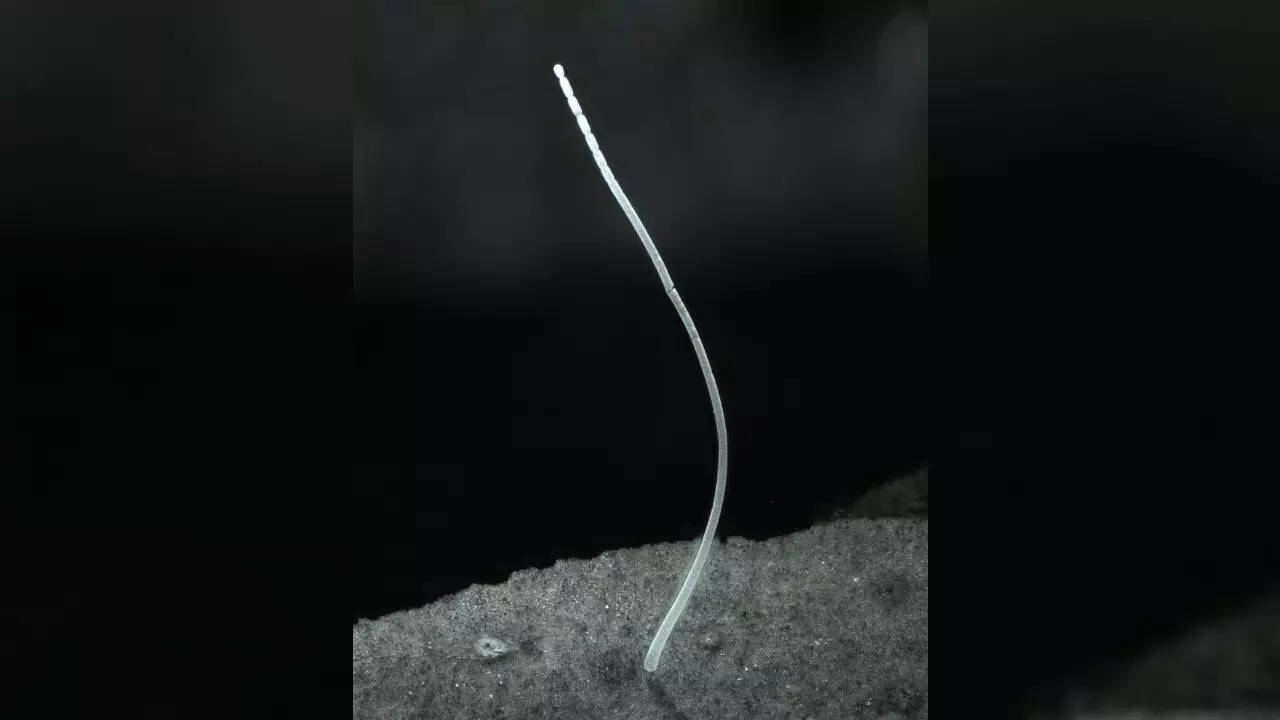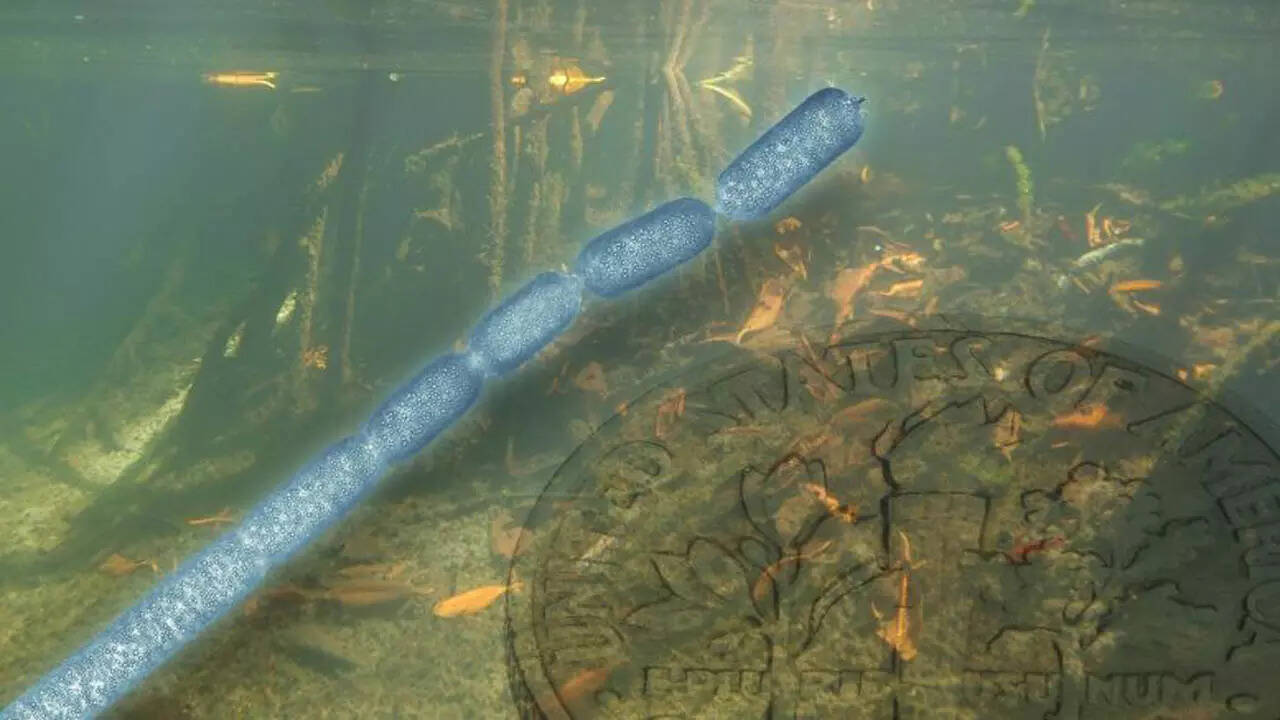‘Size of a human eyelash’: What sets the world’s largest bacterium apart
Scientists have discovered a long, bizarrely-complex bacterium, which defies all textbook definitions of what a unicellular microorganism is. It looks like ultrathin vermicelli and can be seen with a naked eye. As per the discoverers, it is the equivalent for us, humans, to encounter another human who would be as tall as Mount Everest!

You don't need a microscope: A picture of a single filament of Ca. Thiomargarita magnifica. | Credits: Jean-Marie Volland/ Science
What’s the first word that comes to mind when you think of bacteria? It’s probably small, minute, invisible to the naked eye, or something in that vein. We usually associate bacteria with organisms that can only be seen using a microscope. It turns out we were wrong all this time. According to a report published in the journal Science, scientists have discovered a giant white bacterium lurking on rotting leaves in the saline waters of a red mangrove swamp in Guadeloupe in the Lesser Antilles.
The average bacterium is typically between ~0.4 and 3 μm3 in volume and hence only visible with a powerful compound microscope. Such a microscope uses multiple objective lenses that can be switched between to increase the magnification levels. Until now, all bacteria were considered microbial or microscopic organisms.
The recently discovered bacteria — Thiomargarita Magnifica — defies all these stereotypical definitions by simply being visible to the naked eye. It’s almost 1 cm in length, and this discovery helps solve the puzzle of which factors determine the size of a cell.
Previously discovered giant bacteria, some of which could form centimetres-long filaments, are made of hundreds of thousands of cells. However, Thiomargarita Magnifica is composed of a single bacterial cell and is roughly the size of a human eyelash.

The new find is “by far the largest bacteria known to date,” Jean-Marie Volland of Lawrence Berkeley National Laboratory and the Laboratory for Research in Complex Systems said at a news conference. “These bacteria are about 5,000 times larger than most bacteria.”
Scientists call this newly discovered bacteria Thiomargarita Magnifica because of its size and the pearl-like beads of sulphur found inside the cell. Not only is this bacterium a thousand times bigger than a typical bacterium, but it’s also much longer than many multicellular organisms, including fruit flies.
“To put things into perspective, it is the equivalent for us humans to encounter another human who would be as tall as Mount Everest,” Volland added.
“The discovery of this new Thiomargarita bacterium makes us appreciate the incredible diversity of the microbial world, and the intricate structural and genomic adaptations of bacteria that allow them to grow towards cell sizes that nobody would have expected,” Andreas Teske, a marine biologist at the University of North Carolina at Chapel Hill, said in a National Geographic report.
Teske had co-discovered the world’s previous biggest bacterium, Thiomargarita namibiensis, found in the sediments below the waters of Namibia’s Skeleton Coast. At that time, Thiomargarita namibiensis had a diameter that was 100 times bigger than the average bacterium. This bacterium was known to be big because 98 per cent of its volume was used as a storage space to contain reserves of nitrate under a thin layer of cytoplasm, a thick solution that fills each cell and is bounded by the cell membrane.
Oliver Gros, a mangrove biologist at the University of the French Antilles in Guadeloupe, first found the newly categorised bacterium, according to a National Geographic report.
“I spend a lot of time in the water looking at different things in the mangrove sediments. One time I saw these long white filaments, so I just collected them out of curiosity,” Gros said.
The scientists at Gros’s lab first believed that Thiomargarita Magnifica was a fungus or some other multicellular organism. However, their analysis hinted at the fact that this bacterium might belong to the Thiomargarita family of bacteria. But they weren’t a hundred per cent sure, so a group of scientists then created high-magnification, three-dimensional photographs of these long specimens. This enabled them to view the large cells that constituted a filament.
The team showed that the structure of this bacterium is sub-divided into multiple compartments that perform various functions and dramatically increase available surfaces. This complexity has enabled the organism to overcome the long-defined limits for bacterial cell size.
Like Thiomargarita namibiensis, storage space takes up a lot of the volume of the newly discovered bacterium. Nitrate is stored in a large vacuole that accounts for 75 per cent of the total cell volume in Thiomargarita Magnifica. The large vacuole is likely filled with nitrate, and a thin layer of cytoplasm contains sulphur granules, which are involved in the metabolism process, as reported in the latest study.
The cytoplasmic layer of Thiomargarita Magnifica is only about two to three μm (micrometre, or 1×10⁻⁶ of a meter) in depth, which aids in the diffusion process and the transfer of nutrients and molecules into the cell as well as the export of the waste products out. The sulphur granules are essential for respiration, and the cytoplasm houses a complex network of membranes.
How such a large bacterium stimulates biosynthesis (the process of producing complex molecules within living organisms or cells) remains unknown, as per the authors of the study. The mechanisms that control the import of metabolites and export of waste products, as well as the bacterium’s response to environmental stress, are a mystery as of now.
Finding answers to these questions will require devising methods that will allow Thiomargarita Magnifica to grow in culture. This is something that has been achieved in the past only for a small number of bacterial species due to their elusive growth requirements.
“More philosophical in nature is the question of whether T. Magnifica represents the upper limit of bacterial cell size,” the authors of the study noted. “It seems unlikely, and, as the study of Volland et al. illustrates, bacteria are endlessly adaptable and always surprising - and should never be underestimated.”
Trending:
End of Article
Subscribe to our daily Newsletter!





Related News





Tech Layoffs 2024: Experts Explain Why The Tech Industry Is Most Affected

Who Built NASA's James Webb Space Telescope?

Explained: What Is 60% Kannada Rule That Saw Violent Protests In Bengaluru

Disease X Versus COVID-19: What Are Similarities And Difference Between Two

Are We Prepared to Deal with Disease X?









